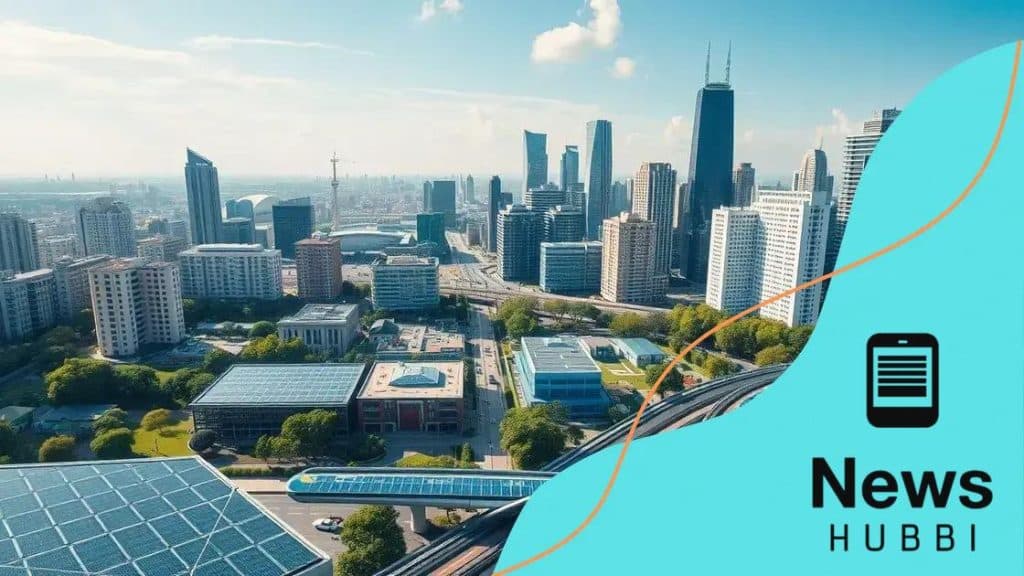How smart cities are addressing urban sustainability challenges

Anúncios
Community involvement in sustainability initiatives enhances decision-making, fosters local engagement, and leads to more effective environmental solutions through collaborative projects and educational programs.
How smart cities are addressing urban sustainability challenges is becoming increasingly important for the future of urban living. Have you ever wondered how cities can evolve sustainably?
Anúncios
The role of technology in urban sustainability
Technology plays a crucial role in making cities more sustainable. By integrating smart solutions, urban areas can reduce their environmental impact and improve the quality of life for residents.
Smart technologies in waste management
One of the significant advancements in urban sustainability is the use of technology for effective waste management. Techniques such as smart bins equipped with sensors can monitor waste levels and optimize collection routes.
- Reduce operational costs
- Minimize carbon emissions
- Promote recycling efforts
Moreover, digital platforms can encourage citizens to participate in recycling programs, creating a community-focused approach to waste management.
Anúncios
Energy efficiency through smart buildings
Energy-efficient buildings are another prime example of technology’s impact on sustainability. These structures rely on smart sensors and automation to monitor and control energy usage, leading to significant savings.
- Adaptive lighting that adjusts based on occupancy
- Smart heating and cooling systems
- Integration of renewable energy sources
This not only reduces energy consumption but also contributes to lower greenhouse gas emissions, promoting a healthier environment.
Furthermore, technology supports sustainable urban planning by enabling detailed data analysis. With tools such as Geographic Information Systems (GIS), city planners can visualize and manage urban development more effectively.
The incorporation of IoT devices allows cities to gather real-time data on traffic patterns, air quality, and energy usage. This data-driven approach empowers city officials to make informed decisions that enhance public infrastructure and ecological integrity.
As technology advances, its role in urban sustainability will only grow stronger, paving the way for cities that are livable, efficient, and environmentally friendly.
Innovative waste management practices
Innovative waste management practices are essential for creating sustainable cities. These practices use advanced technology and smart solutions to reduce waste, minimize environmental harm, and promote recycling.
Smart waste collection systems
Many cities now implement smart waste collection systems. These systems use sensors in waste bins to monitor fill levels. This data allows waste management teams to optimize collection routes, which saves time and fuel.
- Reduced emissions from collection trucks
- Lower operational costs
- Improved waste sorting efficiency
By knowing when bins are full, cities can schedule pickups only when necessary, making waste collection more efficient.
Waste-to-energy programs
Another innovative practice is the conversion of waste into energy. In these programs, materials like food scraps and non-recyclable plastics are processed to create renewable energy.
- Decreases landfill waste
- Generates sustainable power
- Reduces dependency on fossil fuels
This approach not only helps manage waste but also contributes to a city’s energy supply, fostering a greener urban environment.
Additionally, educational campaigns are key in encouraging recycling and composting among residents. Programs that teach communities about waste separation can significantly increase the amount of material diverted from landfills.
Engaging the public in waste management through apps and platforms that provide real-time information on waste recycling points can motivate more residents to participate in sustainable practices.
As cities adopt these innovative waste management practices, they take significant steps toward becoming smarter and more sustainable. The ongoing development of new technologies will continue to drive progress in this essential area.
Energy efficiency in smart buildings

Energy efficiency in smart buildings is vital for sustainability and reducing overall energy consumption. These buildings incorporate advanced technology to monitor and optimize energy use, resulting in lower utility costs and a smaller carbon footprint.
Smart lighting systems
One of the key features of energy-efficient buildings is the use of smart lighting systems. These systems adjust the brightness based on natural light or occupancy, reducing unnecessary energy waste.
- Automatic dimming in response to daylight
- Motion sensors to turn off lights in empty rooms
- Energy-efficient LED bulbs
This innovative approach not only saves energy but also enhances the comfort of the space.
Heating and cooling automation
Heating and cooling are significant contributors to energy use in buildings. Smart buildings utilize automated HVAC systems that learn and adapt to occupancy patterns. This means they can adjust the temperature based on when and where people are present.
- Programmable thermostats for personalized comfort
- Geofencing technology to optimize heating and cooling when people are nearby
- Integration with renewable energy sources like solar panels
By using these technologies, buildings can significantly reduce their energy consumption while maintaining a comfortable environment.
Additionally, real-time energy monitoring allows building managers to identify inefficiencies and take corrective actions promptly. Integrating IOT devices further enhances this capability, providing data on energy usage and helping to optimize performance.
This proactive approach in managing energy not only lowers costs but also aligns with sustainability goals, contributing to a healthier planet. As technology evolves, the potential for energy efficiency in smart buildings will continue to expand, leading the way for a greener future.
Public transportation improvements in smart cities
Public transportation improvements in smart cities are essential for creating efficient and sustainable urban environments. These enhancements focus on making transit more accessible, reliable, and environmentally friendly.
Integration of technology
Many smart cities are adopting advanced technologies to improve public transportation systems. Mobile apps provide real-time updates on bus and train arrivals, allowing passengers to plan their journeys more effectively.
- Live tracking for buses and trains
- Mobile ticketing options for convenience
- Data analytics to optimize routes and schedules
This integration not only increases user satisfaction but also reduces waiting times and minimizes overcrowding.
Eco-friendly transportation options
Smart cities are also emphasizing eco-friendly transportation. Initiatives like electric buses and bike-sharing programs play a significant role in reducing emissions associated with public transit.
- Transitioning to electric and hybrid vehicles
- Creating dedicated bike lanes to encourage cycling
- Expanding pedestrian pathways for safer, walkable cities
By promoting these alternatives, cities can lower their carbon footprints while improving overall air quality.
Additionally, the implementation of smart traffic management systems helps optimize traffic flow and reduce congestion. These systems utilize real-time data to adjust traffic signals and improve routing.
As public transportation becomes more efficient, it encourages more people to choose transit over personal vehicles, leading to less traffic and a more sustainable urban environment.
These improvements not only enhance the quality of public transportation but also foster a greater sense of community and connectivity among residents. As cities continue to grow, public transportation must evolve alongside to meet the needs of the population effectively.
Community involvement in sustainability initiatives
Community involvement in sustainability initiatives is crucial for fostering a culture of environmental responsibility. When residents actively participate, it leads to more effective and long-lasting solutions for urban sustainability.
Engaging local residents
One effective way to involve the community is through educational programs that raise awareness about sustainability practices. Workshops, seminars, and local events can provide valuable information on topics like recycling, energy conservation, and sustainable gardening.
- Hosting community clean-up days
- Creating local recycling competitions
- Offering incentives for sustainable behaviors
These activities not only educate but also bring people together, fostering a sense of community pride.
Collaborative projects
Collaborating on projects can further enhance community involvement. By encouraging residents to contribute ideas and participate in decision-making, cities can develop initiatives that resonate with the community’s needs.
- Developing community gardens
- Implementing local energy efficiency programs
- Building green spaces such as parks or urban forests
When people feel their voices are heard, they are more likely to participate actively in sustainability efforts.
Additionally, online platforms can support community engagement by providing a space for residents to share ideas and resources. These platforms can facilitate discussions and promote events focused on sustainability.
As communities come together to tackle environmental challenges, their collective efforts can lead to innovative solutions that might not have emerged otherwise. Ultimately, ensuring that community members feel empowered and involved is key to the success of sustainability initiatives in smart cities.
\n
| 🏡 Community Engagement | 🌍 Sustainability Impact |
|---|---|
| Education Programs | Raise awareness on key sustainability practices. |
| Collaborative Projects | Encourage community co-creation and shared solutions. |
| Local Events | Fosters community pride and teamwork. |
| Empowerment | Involvement in decision-making leads to ownership. |
| Sustainable Future | Together, we create a healthier planet. |
\n
\n
FAQ – Frequently Asked Questions about Community Involvement in Sustainability Initiatives
Why is community involvement important for sustainability initiatives?
Community involvement is crucial because it leads to better decision-making and more effective solutions for environmental challenges.
What types of activities can engage the community in sustainability?
Activities such as educational workshops, community clean-up days, and local gardening projects can actively involve residents in sustainability efforts.
How can technology facilitate community engagement?
Technology can create online platforms for residents to share ideas, resources, and updates about sustainability initiatives, enhancing communication and participation.
What impact can collective community efforts have on the environment?
Collective community efforts can significantly reduce waste, lower carbon footprints, and promote a culture of sustainability that benefits the entire neighborhood.





